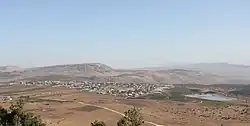Alma
עַלְמָה | |
|---|---|
 | |
 Alma  Alma | |
| Coordinates: 33°3′4″N 35°30′0″E / 33.05111°N 35.50000°E | |
| Country | |
| District | Northern |
| Council | Merom HaGalil |
| Affiliation | Hapoel HaMizrachi |
| Founded | 1 September 1949 |
| Founded by | Libyan Jews |
| Population (2021)[1] | 705 |
Alma (Hebrew: עַלְמָה) is a religious Jewish moshav in the Upper Galilee in northern Israel. It falls under the jurisdiction of the Merom HaGalil Regional Council. In 2021, it had a population of 705.[1] It is built on the basaltic plateau north of Safed.
History
Roman and Crusader eras
Under the Judaea Province, a Jewish town was situated at this spot. The name Alma is first mentioned in the Crusader period. The Jewish community existed until the 17th century.[2] Benjamin of Tudela (1130–1173) said that during his visit, he found 50 Jewish families living in Alma.[3]Ceramics from the Byzantine era have been found here.[4] Alma had several nearby khirbas, and fragments of inscriptions from an ancient synagogue were found at the site of the village in the 20th century. Remains of a ruined watch-tower was found on the crest of the ridge, and a quarter of a mile south of those there were three perfect dolmens, not very large.[5]
The Crusaders called the village "Alme"; it remained under their rule until 1187.[6] While travelling though the region in the 12th century CE, Benjamin of Tudela noted that Alma contained fifty Jewish inhabitants and a "large cemetery of the Israelites", where several sages mentioned in the Mishnah and Talmud were buried.[7] An anonymous Hebrew manuscript of the period mentions that the village's inhabitants were Jews and Muslims, and the lord apparently Frankish. The narrative tells that on every Shabbat Eve, Jews and Muslims light candles on the tomb of Rabbi Eleazar ben Arach, a tanna and a local tzadik (righteous man), and mentions a nearby miracle-working tree.[6]
Ottoman era
The nearby site of the Arab Palestinian village of Alma, whose land Alma stands on, was destroyed in the 1948 Arab–Israeli War.[2]
State of Israel
Moshav Alma was founded on 1 September 1949 by immigrants to Israel from Libya. In 1953, a group of converts to Judaism, known as the Jews of San Nicandro, arrived from Italy. They later abandoned Alma to live in other nearby moshavim. After the Italians left, Cochin Jews arrived from India.[2] By 1968, Alma's inhabitants were mostly from Libya and Tunisia. The economy is based on hillculture (vineyards, deciduous fruit, vegetables) and cattle. In its early years of development, Alma was associated with Hapoel HaMizrachi.
Archaeology
Near the moshav's cemetery lie the remnants of what has been identified as a synagogue, perhaps dating to the 3rd century, though it has never been systematically excavated or properly researched. Also nearby are several tombs, including those of two prominent Sages (tannaim) of the 1st and 2nd centuries CE, one belonging to Eleazar ben Arach, and one which is traditionally recognized as Eliezer ben Hurcanus' tomb.[2]
Landmarks
Alma is located about 600 m above sea level, in an area called Alma Heights, bordered by the Dishon Stream. The Dishon Stream Nature Reserve is located next to the village, as well as the Circassian village Rehaniya.
References
- 1 2 "Regional Statistics". Israel Central Bureau of Statistics. Retrieved 22 February 2023.
- 1 2 3 4 Mapa's concise gazetteer of Israel (in Hebrew). Yuval El'azari (ed.). Tel Aviv: Mapa Publishing. 2005. p. 424. ISBN 965-7184-34-7.
{{cite book}}: CS1 maint: others (link) - ↑ HaReuveni, Immanuel (1999). Lexicon of the Land of Israel (in Hebrew). Miskal - Yedioth Ahronoth Books and Chemed Books. p. 763. ISBN 965-448-413-7.
- ↑ Dauphin, 1998, p. 647
- ↑ Conder and Kitchener, 1881, SWP I, p. 220
- 1 2 Kedar, Benjamin Z. (2005). Holy Men in a Holy Land: Christian, Muslim and Jewish Religiosity in the Near East at the Time of the Crusades. Hayes Robinson Lecture Series No. 9. London: Royal Holloway, University of London. p. 21.
- ↑ Benjamin of Tudela in Thomas Wright. Early Travels in Palestine. Courier Corporation; 2003. ISBN 978-0-486-42871-0. p. 89.